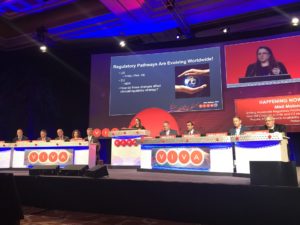
At the 2019 Vascular Interventional Advances (VIVA) conference in Las Vegas, USA (4–7 November), Misti Malone (US Food and Drug Administration [FDA] Office for Cardiovascular Devices, Silver Spring, USA), gave an update on the regulatory landscape, outlining various recent changes, as well as highlighting efforts to “drive global cooperation at the device level”.
“I hope you do not consider the FDA the most challenging and controversial aspect in clinical care,” Malone began, speaking during VIVA’s opening session on the most controversial clinical challenges of 2019. Aiming to set the record straight, she clarified: “We are here to interact and be collaborative with you, and we appreciate the hard work that you are doing”.
Malone then moved into a discussion of the “evolving” regulatory pathways across the world. Firstly, Malone considered the US FDA 510k pathway, which is required for most Class II, medium-risk, devices, including guidewires, introducers, balloon catheters, and peripheral atherectomy devices. She detailed that this pathway requires demonstration of “substantial equivalence” to a legally-marketed predicate device, meaning that the device design, performance, and intended use must be similar to a Class II device that is currently on the market.
She then reported that on 20 September 2019, the FDA released a new guidance regarding an alternative 510k process, called the Safety and Performance-based Pathway, or SPP. While this is based on the predicate device equivalence benchmark that underlies the current pathway, there must also be performance testing, involving FDA-specified methods and criteria that may be based on recognised standards and historical performance of comparable devices, rather than side-by-side testing with a specific marketed devices.
Malone admitted that due to the “complex and evolving” nature of cardiovascular device technology, identifying performance criteria may prove challenging and “it is not our goal to reduce innovation, it is to help support it by allowing the process to move as efficiently as possible”.
“One of the goals of this new pathway is that it will be more similar to regulatory paradigms in other countries,” Malone remarked, addressing the potential benefits of the recently-released guidance update. Malone referenced in particular the third party certification in the Japanese system which relies on performance criteria set by the Japanese government but includes few cardiovascular devices. “This may be a pathway that will be valuable for some of our simpler devices in which we can set these performance criteria,” she concluded. She posited that the new pathway “may facilitate global regulatory decision-making”.
Malone reported that, in the European Union (EU), adoption of the Medical Devices Regulation (MDR) is likely to take effect in May 2020, however there is “continued discussion” on the topic. She outlined one goal of this update being to reinforce provisions for clinical evidence so that clinical evaluation will be required premarket for some devices and that this will continue in the post-market with regular updates, surveillance, and analyses. Two additional goals will be to encourage transparency, using UDI traceability, and also data availability for both clinicians and patients. “The EU hopes that this will provide more information to support clinical decision-making and patient decision-making,” Malone concluded.
According to Malone, devices that are most likely to require clinical investigation under the MDR are those that are implants and high-risk devices, devices that may be Class II or lower where the technology has little or no experience, or a device for which the intended purpose is being extended or if there is a new indication for use. For Class III and implantable devices, she detailed that a post-market clinical follow-up report “may be required”.
Addressing how these changes may affect device availability, Malone commented: “I think this is more of a question for industry, however we look to clinicians to help us understand the ramifications of some of the regulatory decisions and also to involve a global consensus so the process can be efficient”.
Harmonisation through global collaboration
Malone mentioned that there are a number of global groups, such as the International Medical Device Regulators Forum (IMDRF), in which regulators cooperate with numerous countries across the globe. “This is a voluntary effort among medical device regulators to harmonise various regulatory requirements across their jurisdictions,” she explained, concluding that the forum is “driving global cooperation at the device level”.
The FDA consider collaborations like the IMDRF as part of their “strategic priority” to put in place the foundations for creating a Medical Device Single Review Programme, Malone reported, with the potential goal that, once this has been established, some market authorisations in one place may be supported in another country.
Malone also mentioned that the USA collaborates closely with Japan due to the “similar regulatory environments and patients”. She described that there have been a number of recent developments in Japan, including the Sakigake (pioneer) device scheme, shifts in pre- and post-market balance similar to the FDA, the use of non-domestic data, the establishment of registries, and the use of “real-world” evidence and pathways for early feasibility studies.
Malone summarised that many regulatory jurisdictions are establishing different regulatory approaches for medical devices. In the USA, new processes have been developed that “may be appropriate to follow in some cases” but are “not the only options,” Malone detailed. “[The FDA] continues to work interactively with our companies and our clinicians to create an efficient and predictable pathway,” she added. Malone closed the presentation by urging VIVA delegates: “Please consider global strategies when appropriate”.













